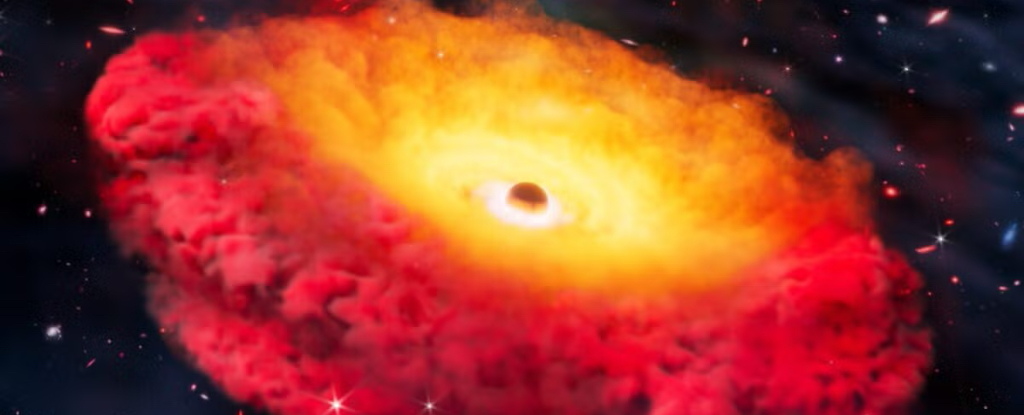
Astronomers have confirmed the existence of the earliest and most distant black hole known to date, located in the galaxy CAPERS-LRD-z9. This black hole, which formed approximately 500 million years after the Big Bang, boasts a staggering mass of around 300 million solar masses, making it extraordinarily large for its time in cosmic history.
This discovery not only highlights the massive scale of this ancient black hole but also sheds light on a perplexing group of celestial objects known as Little Red Dots (LRDs). These intriguing entities emerged around 600 million years post-Big Bang and began to fade away less than a billion years later. The James Webb Space Telescope (JWST) has provided unprecedented infrared observations that reveal these LRDs during the Universe’s early epochs.
Understanding the Cosmic Context
The newly identified black hole is categorized as an active galactic nucleus (AGN), characterized by its bright, rapidly consuming mass at the center of the galaxy. Its reddish appearance is attributed to being enveloped in a luminous cocoon of gas and dust, which has led some to refer to it as a “black hole star.” The immense gravitational force of this supermassive black hole accelerates surrounding gas to speeds of approximately 3,000 kilometers per second, or about 1 percent of the speed of light. This high-velocity gas creates unique spectroscopic signatures that enable astronomers to infer the presence of black holes.
Lead author Anthony Taylor, an astrophysicist at the University of Texas at Austin, explained, “There aren’t many other things that create this signature.” Spectroscopy, the technique used to analyze the light emitted by objects in space, reveals how light waves from the gas surrounding the black hole stretch and shift in color, providing insights into the object’s velocity and mass.
Importantly, the confirmation of CAPERS-LRD-z9 supports the hypothesis that LRDs are likely to contain supermassive black holes. Some of these black holes may reach up to 10 million solar masses within their first billion years, which is particularly significant when compared to the supermassive black hole at the core of the Milky Way, estimated at about 4 million solar masses.
Black Hole Growth and Formation Theories
The scale of the black hole within CAPERS-LRD-z9 indicates that it may be “overmassive,” with mass ratios approaching 10 to 100 percent of its host galaxy’s stellar mass. Specifically, this black hole may account for about half the total mass of all stars within its galaxy. In contrast, central black holes in more nearby galaxies typically comprise only about 0.1 percent of their stellar mass.
Researchers propose two primary pathways for such massive black hole formation within just 500 million years of cosmic time. The first scenario suggests a large “seed” black hole growing at the theoretical upper limit of black hole growth, known as the Eddington rate, starting with around 10,000 solar masses. Alternatively, a smaller seed, perhaps just 100 solar masses, could achieve rapid growth at the super-Eddington rate, aided by the dense gas surrounding it.
These seed black holes may have originated from primordial black holes formed during the Big Bang, or they could result from the collapse of the first stars in the universe, known as Population III stars, or through collisions in dense star clusters.
The findings contribute to the understanding of LRDs as transient phenomena in the early universe and suggest they played a critical role in galactic evolution, potentially setting the stage for the formation of galaxies like the Milky Way. This research has been published in the Astrophysical Journal Letters.
As researchers continue to refine their methods of exploring the cosmos, Taylor noted, “When looking for black holes, this is about as far back as you can practically go. We’re really pushing the boundaries of what current technology can detect.”







